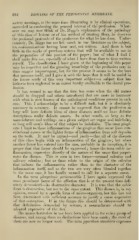Page 944 - My FlipBook
P. 944
954 DISEASES OF THE PERIDENTAL MEMBRANE.
society meetings, at the same time illustrating it by clinical operations,
succeeded in awakening the general interest of tlie profession. AVhat-
ever we may now think of Dr. Riggs's explanation of the pathology
of this class of lesions or of his method of treating them, he deserves
the profound gratitude of the profession for what he has done. Unfor-
tunately, Dr. iliggs has not left much in our literature on the subject,
his communications having been oral, not written. And there is but
little in the works of previous writers tiiat will be available to me in
the preparation of this portion of the paper ; but of what I find I
shall make free use, especially of what I have from time to time written
myself The classification I have given at the beginning of this paper
may be imperfect and the growing knowledge of the profession may in
time suggest improvement, but for the present it seems to be the best
that presents itself, and I give it with the hope that it will be useful in
the future study of this very important subject—a subject that has
hitherto been neglected to an extent hardly creditable to the dental pro-
fession.
It has seemed to me that the time has come when the old names
should be dropped and others introduced that are more in harmony
with what is now known of the pathological conditions present in each
case. This I acknowledge to be a difficult task, but it is absolutely
necessary to accuracy. It cannot be expected that the profession at
large will have definite ideas of these diseases until we have definite
descriptions under definite names. In other words, so long as the
nomenclature and writings on a given subject are vague and indefinite,
so long will men's ideas of that subject be indefinite. The term gingi-
vitis I limit to those inflammations of the gingivae that occur from con-
stitutional causes or the lighter forms of inflammation from soft deposits
on the teeth. It may be argued—and justly—that all of the diseases
of this class begin with an inflammation of the gingivae ; but when
another factor has entered into the case, probably in its inception, it is
jiroper that that factor should be expressed ; hence the term calcic in-
flammation, expressive directly of the nature of the cause that perpet-
uates the disease. This is seen in two forms—serumal calculus and
salivary calculus ; but as these relate to the origin of the calculus
that induces the inflammation rather than to the character of the
inflammation itself, and as the two are very often blended together
in the same case, it has hardly seemed to call for a separate name.
In the term phagedenic pericementitis I have again expressed the
most prominent factor of the affection that is at the present time defi-
nitely determined—its destructive character. It is true that the calcic
form is destructive, but not to the same extent. This disease is, in my
opinion, caused by a specific form of micro-organism, but this has not
been determined with sufficient accuracy to justify a name expressive
of that conce])tion. If in the future this should be determined with
that definiteness demanded by science, a nomenclature should be
ado]>ted expressive of the fact.
The names heretofore in use have been applied to the entire group of
diseases, and among them no distinctions have been made ; the most of
them are now no longer used. The term pyorrhoea alveolaris expresses


